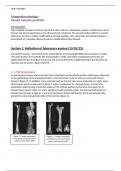Faunal Study guides, Revision notes & Summaries
Looking for the best study guides, study notes and summaries about Faunal? On this page you'll find 48 study documents about Faunal.
Page 3 out of 48 results
Sort by

-
NATS 1540 final exam 2023 with 100% correct answers
- Exam (elaborations) • 6 pages • 2023
- Available in package deal
-
- £12.47
- + learn more
what is the tertiary period (According to the coursekit article) - the rise of dominance of the mammals. - what happened by the early Eocene in the late cretaceous period, mammals that lived in the undergrowth and hid from the dinosaurs, now more than 20 orders of mammals evolved rapidly and were established by the early Eocene. what happened at the end of the Paleocene? a major episode of faunal turnover largely replaced archaic groups with essentially modern groups such as th...

-
ANTH Exam 1 (with Complete Solutions
- Exam (elaborations) • 8 pages • 2023
-
- £8.44
- + learn more
Ache correct answers Hunters of Paraguay, after 400 kya, bigger brains and meat eaters, hunger/gatherers Acheulean correct answers stone tool industry of the early and middle pleistoscene characterized by the presence of bifacial hand axes & clevers, associated with Homo erectus and early Homo sapiens Anatomically Modern Humans correct answers first evidence traces back to 160,000 years ago homo sapiens, middle Paleolithic, look like us, don't behave like us Anthropology correct answe...
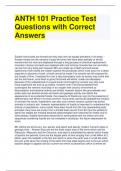
-
ANTH 101 Practice Test Questions with Correct Answers
- Exam (elaborations) • 19 pages • 2024
- Available in package deal
-
- £10.62
- + learn more
ANTH 101 Practice Test Questions with Correct Answers Explain how fossils are formed and why they are not equally prevalent in all areas. - Answer-fossils are the remains of past life forms that have been partially or wholly transformed into rock and displaced through a long process of chemical replacement. minerals in bones and teeth are replaced with rock forming minerals like iron and silica. can be from any body part however 99% are made up of teeth and and bones. taphonomy (how fossils a...

-
Test Bank For Big History Between Nothing and Everything 1St Edition By david Christian
- Exam (elaborations) • 61 pages • 2023
-
- £24.49
- + learn more
Chapter 03: The Emergence of Life True/False 1. One basic characteristic of living matter is that it is in chemical equilibrium; that is, it is in a stable, balanced condition with reciprocal reactions going on. Answer: False Page: 56 Explanation: One basic characteristic of living matter is that chemically it is not in equilibrium; that is, it is not in a stable, balanced condition with reciprocal reactions going on. Instead, in living cells energy flows take place as membranes let some ch...

-
ANP 203 Exam 2 Questions with complete solution
- Exam (elaborations) • 10 pages • 2023
- Available in package deal
-
- £11.66
- + learn more
ANP 203 Exam 2 Questions with complete solution how do archaeologists order artifacts into time series (seriation) using the principle of superstition? how do artifacts serve as time markers and help archaeologists cross-date sites? artifacts are ordered earliest (deeper) --> latest, (overlie) showing that deeper, underlying levels are older than those that overlie them. some artifacts that are dated can serve as markers for similar artifacts that are not yet dated and help sequence these....
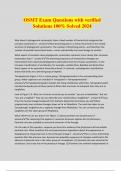
-
OSMT Exam Questions with verified Solutions 100% Solved 2024
- Exam (elaborations) • 10 pages • 2024
- Available in package deal
-
- £10.05
- + learn more
OSMT Exam Questions with verified Solutions 100% Solved 2024 Why doesn't phylogenetic systematics have a fixed number of hierarchical categories like Linnaean systematics? - answerEach branching point is a hierarchical level in the nested structure of phylogenetic systematics. The number of branching points—and therefore the number of possible hierarchical levels—varies substantially from one lineage to another. What aspect of evolution does phylogenetic systematics represent more c...
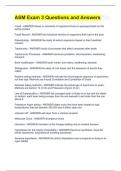
-
ASM Exam 3 Questions and Answers
- Exam (elaborations) • 4 pages • 2024
- Available in package deal
-
- £8.44
- + learn more
Fossil - ANSWER-traces or remnants of organisms found in geological beds on the earths surface Fossil Record - ANSWER-the fossilized remains of organisms that lived in the past Paleontology - ANSWER-the study of extinct organisms based on their fossilized remains Taphonomy - ANSWER-study of processes that affect carcasses after death Taphonomic Processes - ANSWER-carnivore predation, decomposition, weathering, transport Bone modification - ANSWER-tooth marks, tool marks, weatherin...
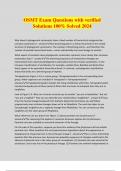
-
OSMT Exam Questions with verified Solutions 100% Solved 2024
- Exam (elaborations) • 10 pages • 2024
- Available in package deal
-
- £10.05
- + learn more
OSMT Exam Questions with verified Solutions 100% Solved 2024 Why doesn't phylogenetic systematics have a fixed number of hierarchical categories like Linnaean systematics? - answerEach branching point is a hierarchical level in the nested structure of phylogenetic systematics. The number of branching points—and therefore the number of possible hierarchical levels—varies substantially from one lineage to another. What aspect of evolution does phylogenetic systematics represent more cle...
we did multiple labs on animal remains, this was a reflective piece of work on one lab of our choosing, with images we took I got a high grade for this work

-
ERSC181 B001 Week 8 COMBINED exams WEEK 1-7 (answered) Fall 2021/2022
- Other • 75 pages • 2021
-
- £8.44
- 2x sold
- + learn more
9/25/2020 APUS CLE : ERSC181 I002 Sum 20 : Tests & Quizzes 4.0/ 4.0 Points 4.0/ 4.0 Points Week 1 Exam (timed and single access) Return to Assessment List Part 1 of 2 - Rock Forming Minerals 52.0/ 52.0 Points Question 1 of 25 Which subatomic particle is NOT found in the nucleus? A. proton B. neutron C. electron Feedback: 3.1.1 Question 2 of 25 Which of the following is considered to be composed of a mineral? A. coal B. your teeth C. glass (un-ordered atoms) D. lab-grown diamond...

Do you wonder why so many students wear nice clothes, have money to spare and enjoy tons of free time? Well, they sell on Stuvia! Imagine your study notes being downloaded a dozen times for £15 each. Every. Single. Day. Discover all about earning on Stuvia



